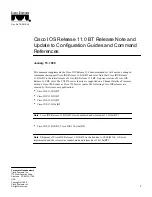
20-3
Catalyst 3550 Multilayer Switch Software Configuration Guide
78-11194-03
Chapter 20 Configuring QoS
Understanding QoS
All switches and routers that access the Internet rely on the class information to provide the same
forwarding treatment to packets with the same class information and different treatment to packets with
different class information. The class information in the packet can be assigned by end hosts or by
switches or routers along the way, based on a configured policy, detailed examination of the packet, or
both. Detailed examination of the packet is expected to happen closer to the edge of the network so that
the core switches and routers are not overloaded.
Switches and routers along the path can use the class information to limit the amount of resources
allocated per traffic class. The behavior of an individual device when handling traffic in the DiffServ
architecture is called per-hop behavior. If all devices along a path provide a consistent per-hop behavior,
you can construct an end-to-end QoS solution.
Implementing QoS in your network can be a simple or complex task and depends on the QoS features
offered by your internetworking devices, the traffic types and patterns in your network, and the
granularity of control that you need over incoming and outgoing traffic.
Basic QoS Model
Figure 20-2
shows the basic QoS model. Actions at the ingress interface include classifying traffic,
policing, and marking:
•
Classifying distinguishes one kind of traffic from another. The process generates an internal DSCP
for a packet, which identifies all the future QoS actions to be performed on this packet. For more
information, see the
“Classification” section on page 20-4
.
•
Policing determines whether a packet is in or out of profile by comparing the internal DSCP to the
configured policer, and the policer limits the bandwidth consumed by a flow of traffic. The result of
this determination is passed to the marker. For more information, see the
“Policing and Marking”
section on page 20-8
.
•
Marking evaluates the policer and configuration information for the action to be taken when a packet
is out of profile and decides what to do with the packet (pass through a packet without modification,
mark down the DSCP value in the packet, or drop the packet). For more information, see the
“Policing and Marking” section on page 20-8
.
Actions at the egress interface include queueing and scheduling:
•
Queueing evaluates the internal DSCP and determines which of the four egress queues in which to
place the packet. The DSCP value is mapped to a CoS value, which selects one of the queues.
•
Scheduling services the four egress queues based on their configured weighted round robin (WRR)
weights and thresholds. One of the queues can be the expedite queue, which is serviced until empty
before the other queues are serviced. Congestion avoidance techniques include tail drop and
Weighted Random Early Detection (WRED) on Gigabit-capable Ethernet ports and tail drop (with
only one threshold) on 10/100 Ethernet ports.
Note
Policing and marking can also occur on egress interfaces.
















































